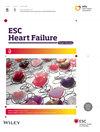Relationship of malnutrition and frailty on prolonged stay at the hospital in heart failure patients
Abstract
Background
Nutritional status is a critical determinant of clinical outcomes in patients with chronic heart failure (CHF), potentially contributing to adverse prognosis and suboptimal therapeutic response. Despite growing interest, the interplay between malnutrition and frailty syndrome (FS) in the CHF population remains inadequately elucidated.
Aims
The study aims to evaluate the association between malnutrition risk and the presence of FS in individuals hospitalized with CHF.
Methods
A total of 200 patients (mean age: 72.28 years) hospitalized due to CHF were enrolled. Data collection included retrospective analysis of medical records and application of validated instruments: the Mini Nutritional Assessment (MNA) for nutritional evaluation and the Fried phenotype criteria for frailty assessment.
Results
Based on MNA, 63.5% of participants demonstrated normal nutritional status, 35.0% were at risk of malnutrition and 1.5% were malnourished (mean MNA score: 24.25). According to the Fried phenotype, 35% were classified as pre-frail and 65% as frail (mean frailty score: 2.67). A statistically significant association was identified between MNA score and frailty status (P < 0.05), with the highest prevalence of frailty observed in malnourished individuals (P = 0.002). No significant correlations were found between frailty and anthropometric parameters such as calf circumference (P = 0.17), arm circumference (P = 0.687) or body mass index (BMI) (P = 0.643).
Conclusions
These findings highlight the clinical importance of routine, comprehensive nutritional screening in patients with CHF. Early identification and management of malnutrition may play a pivotal role in mitigating frailty and enhancing clinical outcomes in this high-risk population.


 求助内容:
求助内容: 应助结果提醒方式:
应助结果提醒方式:


